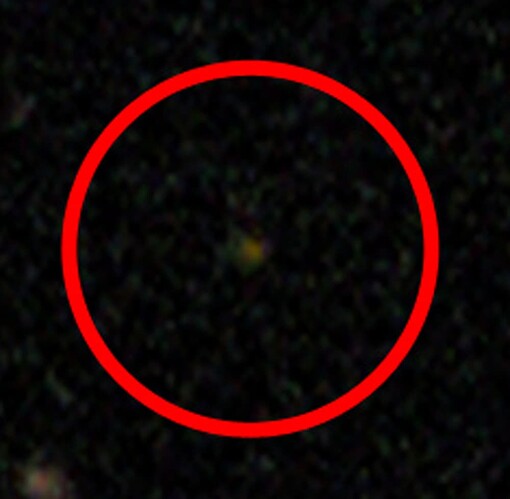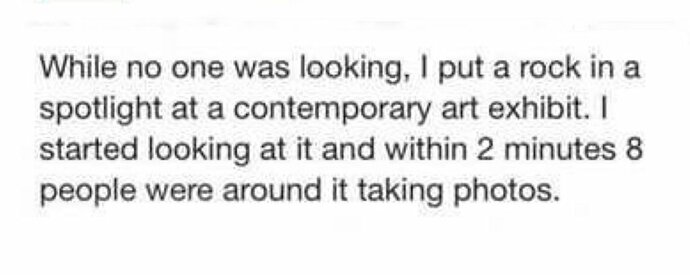It tends to be people who knew each other as students or word of mouth recommendation. In other words much like many other areas of economic activity.
For a next visit to Paris, a street art trail
I’m sure there was a feature about him on France 24 a few months ago, but can’t find it. I’ve seen a few and they took me back to the coarsely pixellated images I used to produce in the late Eighties, before the advent of easily available higher res things like Photoshop. There’s a charm about them that has largely been lost elsewhere.
There’s an excellent book by James Elkins called Six Stories from the End of Representation - it’s about the complexities of digital viewing; it has a chapter on how algorithmic filters are used in astronomy to interpret and enhance images of very distant objects in deep space when a star system might be represented by a handful of pixels.
Six Stories from the End of Representation - Google Books
UDFy-38135539 (ringed in red below) was the most distant object visible made ‘visible’ by the Hubble telescope it is (or was?)13.1 billion light-years away
The detail below is @ 400% magnification; in the centre there’s one dark grey pixel - that’s a whole galaxy, though of course it could be something we can’t even imagine. What they do know is that it’s not dust on the lens ![]()
The algorithms analyse the colours of the small clusters of pixels and these are then interpolated to provide an analysis of what is being recorded (‘depicted’ seems slightly inappropriate).
If one is printing a digital image (RGBD), I think 256 or 512 are still usually the relevant numbers of available colours, but if you’re working with light (RGB) it’s 16 million. However, the human eye is supposed to be able to distinguish still more I remember it being 17 million but that’s pulled up in memory from a couple of decades ago and I aplogise for not providing a ref or a link.
I’m just hoping that all those ‘weather balloons’ the Americans have been shooting down aren’t visitors from another galaxy. They surely will be pissed off. And they possibly have superior tech. ![]()
There’s a science fiction short story I read many years ago - Ray Bradbury? Brian Aldiss? - about a civilisation leaving their dying world and heading for earth and successfully landing. Someone wanders out into their garden and sees all these tiny “bugs” on the ground and stamps on them. ![]()
I think I remember that story! They were very ferocious and what makes it even more dismal for them is they are walked on and destroyed by accident. I think there’s another where aliens take over a species with a view to taking over the planet via it, and unfortunately it is lemmings.
Edited to add I have been trying to find it again and I can’t - I read it over 50 years ago though.
I’d forgotten that bit, thought it was deliberate - all the sadder.
Douglas Adams wrote a spoof cameo version of that in one of the HHGTTG books, where the invading spaceship was eaten by a small dog.
Ah, AM beat me to the HHGTTG reference
The G’Gugvuntts
Yes, and there’s even another similar one where someone thinks they are insects at a picnic I think and sprays them - but the original (or at least I think it is) one is still evading me.
I have read one of the original serious ones, but can’t remember either.
As a former head of a university art school, I disagree for several reasons.
Firstly at least some of the culpability lies with GSA
It ‘basically happened’ because of inadequate implementation or enforcement of normal Health & Safety regs. Either the project’s initial proposal wasn"t properly evaluated and/or there was inadequate workshop training and supervision.
The student may have been ‘stupid’, but more likely was ignorant and for me, that reflects badly on the quality of teaching and level of technicial support.
Secondly, he was only a relatively inexperienced person and not a professional, unlike those restoring the Mack building who accidently started the second far, more severe fire.
Lastly, npthing really to do with a material being ‘modern’ (even if environmentally undesirable); one can cause a lot of accidental harm including starting a fire by mishandling molten bronze in a casting foundry and in 1978, the famous London etching studio, Editions Alecto was destroyed by fire.
Sorry you had such a bad experience at GSA, I’ve had a variety of professional encounters with the institution and was usually unimpressed (though never by the building!) Many things happened at GSA that were not very professional, but I hope most of that is in the past. Unfortunately now nearly all UK art schools are in an increasingly difficult environment and, as you note Brexit hasn’t helped. Certainly, if I was asked to recommend pgFine Art courses, I’d recommend Germany , particulalrly Berlin, universities in the Netherlands, or non-European universities in places cheaper, but excitingly edgier like South Africa’s University of Cape Town or Jo’burgs Wits.
I few years back the UK government removed all remaining financial support from the RCA, but despite that for the past three years it’s been voted the best specialised art & design university in the world, against competition from the the likes of the Chicago Institute and UCLA, so its interesting what can be achieved if an excellent academic institution is able to make itself independent of government control.
Art changes and so do art schools and academies, these are historical inevitabilities and obviously not everyone at all times will view such changes as improvements.
I was slightly confused by :-
[quote=“StirlingMouse, post:217, topic:24093”]
It was an art school and not an ‘academic’ institution[/quote]
Ever since the first art academies in fifteenth century Florence, art schools (which were usually called ‘academies’) were essentially academic institutions whose structure was based on that of existing academies in other disciplines and whose mode of instruction differed from that of artisans’ and tradesmen’s guilds, where a person was apprenticed to a sole master rather than learning in a cohort with various teachers.
Incidetally, the term, ‘art school’ is much later and originally related to the emergence of art history as an academic discipline that grouped artists together on the basis of stylistic similarities. Its use in education dates from the second half of the C19th and was often used to distinguish between national art academies where students studied either fine art or achitecture (les beaux arts) and institutions where students studied ‘applied arts’ -subjects we would now term ‘craft’ and ‘design’.
Oh dear. What a shame ![]()

It certainly is because Koons’ small balloon dogs are rather good.
Last year we were treated to a very fine lunch in a Parisian resto which had one next to our table (safe inside a vitrine). We had our very chic miniature poodle with us (who was given her own chair despite the place being full!) Consequently, over the course of the meal I had plenty of opportunity to study poodle and balloon dog, and concluded Koons had (had) made a very surprisingly lively and animated piece of work. It’s a shame there’s now one less.
Depends on the rock


